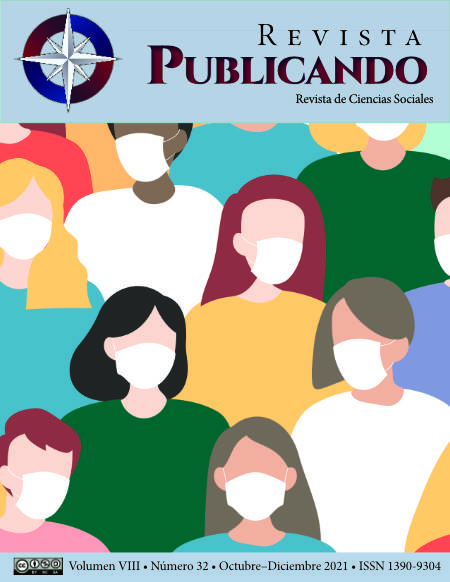Abstract
This research was carried out with the purpose of analyzing how the financial information at fair value reported by companies in the Ecuadorian industrial sector was affected by the asymmetry of financial information generated during the COVID-19 pandemic. The methodology used was non-experimental research supported by descriptive, documentary and correlational research, through which it was found that the asymmetry of financial information is directly related to the risk rating and the accounts that are reported at fair value, which in turn It sometimes generates profit or loss in the entities, a statement based on the exploitation of the multivariate econometric model where negative and positive data were used. The exploitation of the model allowed us to know that if the risk rating of a company in the industrial sector improves from AA to AAA, it will significantly affect the income statement, which suggests that productivity standards should be improved. This research contributed to the area of financial accounting with the help of econometrics. Researchers who wish to continue with this type of research could use the methodology used to collect new results and possible comparisons.
References
Acosta, A. (2020). El coronavirus en los tiempos del Ecuador. Análisis Carolina, 1-19.
Al-Kassar, T. A., & Dannoun, Z. O. (2016). The Importance of Fair Value Accounting to Information Quality on Financial Statements (Field Study of Jordanian Commercial Banks). Research Journal of Finance and Accounting, 7(5), 14-23.
Aura, R. (2015). La asimetría de la información en contabilidad. Universidad La Salle, 1-10.
Banco Central del Ecuador - BCE. (2020). Boletines mensuales. Obtenido: https://www.bce.fin.ec/
Cárdenas-Pérez, A. (2020). El valor razonable y su repercusión en las decisiones gerenciales. Revista Publicando, 7(24), 49-58.
Cárdenas-Pérez, A., & Echeverría, I. B. (2021). Explicación del crecimiento económico en la Economía Popular y Solidaria mediante la aplicación del modelo econométrico de Regresión Lineal y Múltiple. Revista Publicando, 8(28), 74-84.
Comisión Económica para América Latina y el Caribe. (2020, Mayo). Informe sobre el impacto económico en América Latina y el Caribe de la enfermedad por coronavirus (COVID-19). https://www.cepal.org/sites/default/files/publication/files/45602/S2000313_es.pdf
Financial Accounting Standards Board – FASB. (2006). SFAS N° 157 Fair Value Measurements. Financial Accounting Series, September, 1-99.
Gutiérrez, M. (2018). Criterio del valor razonable (NIIF13) en la medición de los activos de propiedad, planta y equipo. Azuay: Universidad del Azuay.
Horne, J., & Wachowicz, J. (2016). Fundamentos de Administración Financiera . México: Jumbo Ordóñez, D. P., Campuzano Vásquez, J. A., Vega Jaramillo, F. Y., & Luna Romero, Á. E. (2020). Crisis económicas y Covid-19 en Ecuador: impacto en las exportaciones. Revista Universidad y Sociedad, 12(6), 103-110.Pearson Education.
IASB (2018). IFRS 13 Fair Value Measurement. London: International Accounting Standards Board.
IFRS. (2016). Marco conceptual para la información financiera. Londres: IFRS.
Lazo, I. (2020). CNIIF 23 Tratamientos impositivos inciertos y los efectos del COVID-19 en empresas del Ecuador. Guayaquil: ESPOL.
León, E. (2018). Valor Razonable, ventajas y desventajas en su método de valuación. Bogotá: UTADEO.
Mantilla, S. (2018). Normas Internacionales de Información Financiera. Colombia: Ecoe Ediciones.
NIC 39. (2016). NIC 39 Instumentos Financieros: Reconocimiento y Medición. Londres: IFRS.
OMS. (11 de Marzo de 2020). World Health Organization. Obtenido de Who Timeline - Covid-19: https://www.who.int/news-room/detail/27-04-2020-who-timeline---covid-19
OMS. (11 de Marzo de 2020). World Health Organization. Obtenido de Who Timeline - Covid-19: https://www.who.int/news-room/detail/27-04-2020-who-timeline---covid-19
Pineida, K. (2016). Análisis de la NIIF 13 y su relación con las empresas comerciales del Ecuador. Universidad Central del Ecuador, 1-110.
SUPERCIAS (2020). Superintendencia de Compañías, valores y Seguros. Obtenido: https://www.supercias.gob.ec/portalscvs/
Shamkuts V. (2010) Fair value accounting. University of Iceland: Faculty of Bussiness Administration. En: http://skemman.is/stream/get/1946/4234/12284/1/Thesis_fixed.pdf. Consultado en: 16/05/2014.
Jeppesen, K.K. & Liempd, Dennis van (2015, Julio- Diciembre). El valor razonable y la conexión perdida entre contabilidad y auditoría (trad. Catherine Moreno y Jesús Suarez); rev. téc. Rafael Franco). Rev. Cient. Gen. José María Córdova 13(16), 135-171.

This work is licensed under a Creative Commons Attribution-NonCommercial-ShareAlike 4.0 International License.
Copyright (c) 2021 Erik Palomo-Guilcamaigua, Jorge Yánez-Gutiérrez, Alisva Cárdenas-Pérez




